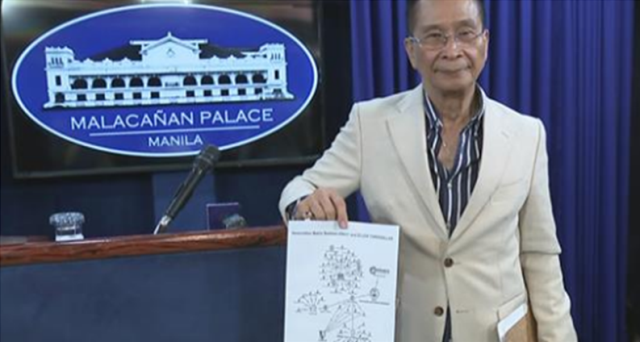Just Another Tall Tale: Covering the “Matrix” Story

IN ITS April 22 banner story “OUST-DUTERTE PLOT BARED” (all caps supplied), The Manila Times alleged that a “coordinated media campaign” involved journalists in a plot to destabilize the Duterte regime. By-lined by Dante Ang, the newspaper’s chairman emeritus (and Duterte’s Special Envoy for International Affairs) and using only anonymous sources, the opinion piece disguised as an exposé was clearly an attempt to dismiss a video which featured one “Bikoy” implicating members of the Duterte family in the activities of a drug syndicate. Ang’s point was to show that the production and distribution of the video was part of a conspiracy against the president.
The “Association Matrix Between Bikoy and Ellen Tordesillas” supposedly showed the links among several journalists, lawmakers, media outfits and lawyers’ and other non-government organizations, and claimed to depict “the flow of news from the source to a nexus or distributor and finally to the individual journalists for publication.”
It also had a “Link Analysis of email foot prints” – supposed to track how the “Bikoy” videos got distributed.
In a televised press briefing that day, Palace spokesperson Salvador Panelo confirmed the allegations in the “matrix” – adding that he was supposed to have been the one to expose it, but the Times beat him to it. He furnished some details: that it was the same “matrix” in the possession of the Office of the President, but they did not furnish the Times a copy; that the source was another country.
Tried and Tired Trick
President Duterte has been claiming for some time that there are parties plotting to oust him. The “matrix” tale is not the first “ouster plot” made public by partisans of the Duterte regime. Last year, the military told the media about a so-called “Red October” plot which included universities among the alleged plotters. Last December, Duterte’s son Paolo posted a screen shot of an Excel file that contained the names of organizations, journalists, Church leaders and various groups that were supposedly conspiring against the administration. The list included the fast food chain Jollibee and Vice President Maria Leonor “Leni” Robredo.
Both “plots” turned out to non-existent. The experience with these fake narratives apparently led the media to be more skeptical about the so-called “matrix.” No news organization treated the latest as anything more than just another tall tale.
CMFR monitored the coverage of the “matrix” tale by primetime newscasts (ABS-CBN 2’s TV Patrol, GMA-7’s 24 Oras, TV5’s Aksyon and CNN Philippines’ News Night) and broadsheets (Philippine Daily Inquirer, Manila Bulletin, The Philippine Star, The Manila Times, Manila Standard and Daily Tribune) from April 22 to 28.
Briefly in the News
The ouster plot gained only brief coverage from the media. Primetime newscasts reported it Monday night while the broadsheets (Inquirer, Star and Standard) ran stories on Tuesday, April 23, based on Panelo’s press briefing. These reports included the reactions of some people and organizations, who called it baseless and pointed out the host of factual inaccuracies in it.
Malacañang reporters had pressed Panelo for more details, such as the source of the information and how reliable it was. Their reports noted Panelo’s failure to provide satisfactory answers, quoting him when he said: he was just asked by the president to “touch on it,” that reporters would have to ask the president himself, that “galing kay presidente kaya dapat paniwalaan ninyo” (It came from the president so you must believe it).
The 6.1 magnitude earthquake rocked Metro Manila and Central Luzon took over the news cycle. But on April 25, the media picked up the news of the resignation of Felipe Salvosa II, managing editor of the Times,
“I felt I had to resign after the publication of the ‘matrix’ story. You could say it was the last straw,” The Star quoted Salvosa, who also said he was asked to resign after he criticized the publication of the story in his social media accounts, and that he told “the owners” that he was planning to do so anyway. The newspaper responded with a statement, claiming that Salvosa had been asked to resign. The broadsheet also said it was standing by the story; and that it was not a PR piece but a legitimate news item.
Reports noted points of context in which the “matrix” was released: the recent investigative report of the Philippine Center for Investigative Journalism (PCIJ) on the unexplained wealth of members of the Duterte family, the Bikoy video itself, that organizations tagged in the “plot” were those engaged in fact checking initiatives or had issued reports critical of war on drugs.
The matrix showed names of people who had long left the organizations they were supposed to have been part of. It identified a journalist and a professor in UP as lawyers; and mentioned anomalous IP addresses. Media has the capacity to check and point out these glaring factual errors ahead of the statements issued by people and organizations. Few noted that even the police and military said that they found no specific security threat; and that they had not found evidence of a plot as shown in the matrix.
Reports could have noted how a newspaper can treat such information as news without checking further about its veracity. The story was defamatory of the reputation of journalists who had been working in the press longer than Dante Ang.
In its April 25 editorial “Malacañang’s Matrix,” the Inquirer observed that “…hardly anyone is fooled. Public laughter and savage memes greeted the release of the matrix.” It ended the piece with “Never mind The Manila Times, but there goes, once again, the credibility of Malacañang and its hapless coven of fabulists, whisperers and amateur illustrators.”
Media could use the same sharp stance and refuse to provide further attention to unfounded claims the next time.
Leave a Reply